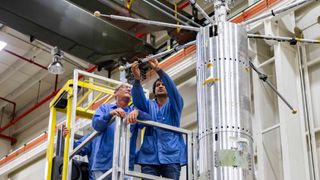News
Science & Astronomy

NASA’s Wallops Flight Facility mechanical technician John Peterson and Aroh Barjatya, a professor of engineering physics at Embry-Riddle Aeronautical University in Daytona Beach, Florida, inspect instruments after a test.
(Image credit: NASA’s Wallops Flight Facility/Berit Bland)
On Oct. 14, an annular solar eclipse — also called a “ring of fire” eclipse — will be seen across parts of the western United States. But while skywatchers and eclipse chasers can sit back, relax, and enjoy the show, some NASA scientists will be hard at work.
Aroh Barjatya, a professor of engineering physics at Embry-Riddle Aeronautical University in Daytona Beach, Florida, is leading a NASA mission that will see three sounding rockets measure changes in the atmosphere during the eclipse. The mission is called the Atmospheric Perturbations around the Eclipse Path, or APEP, which is uncoincidentally the name of the Egyptian deity of darkness. According to tradition, Apep would chase the sun god Ra, his arch nemesis — and when he caught up to him, an eclipse occurred.
Launching from White Sands Missile Range in New Mexico, the rockets will specifically target the ionosphere. During the eclipse, temperature and density will drop in the ionosphere, creating a wave-like effect that can affect satellite communications, including GPS.
Related: Annular solar eclipse 2023: How to watch in person and online
“If you think of the ionosphere as a pond with some gentle ripples on it, the eclipse is like a motorboat that suddenly rips through the water,” Barjatya said in a statement. “It creates a wake immediately underneath and behind it, and then the water level momentarily goes up as it rushes back in.” He adds that because all satellite communications travel through this region, it’s crucial that we “understand and model all perturbations in the ionosphere.”
Following the annular eclipse, the sounding rockets and their instruments will travel to NASA’s Wallops Flight Facility in Virginia, where they will be relaunched during the upcoming total solar eclipse on Apr. 8, 2024. This pair of solar eclipses will be the last major two seen in the contiguous United States until 2044.
“We have to make hay while the sun shines … or, I suppose for eclipse science, while it doesn’t,” said Barjatya. “In all seriousness though, this data set will reveal the widespread effects that eclipses have on the ionosphere at the smallest spatial scales.”
Join our Space Forums to keep talking space on the latest missions, night sky and more! And if you have a news tip, correction or comment, let us know at: [email protected].
Breaking space news, the latest updates on rocket launches, skywatching events and more!
Space.com contributing writer Stefanie Waldek is a self-taught space nerd and aviation geek who is passionate about all things spaceflight and astronomy. With a background in travel and design journalism, as well as a Bachelor of Arts degree from New York University, she specializes in the budding space tourism industry and Earth-based astrotourism. In her free time, you can find her watching rocket launches or looking up at the stars, wondering what is out there. Learn more about her work at www.stefaniewaldek.com.
>>> Read full article>>>
Copyright for syndicated content belongs to the linked Source : Space.com – https://www.space.com/nasa-sounding-rockets-ring-of-fire-eclipse































